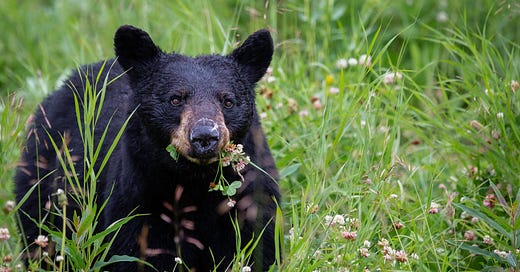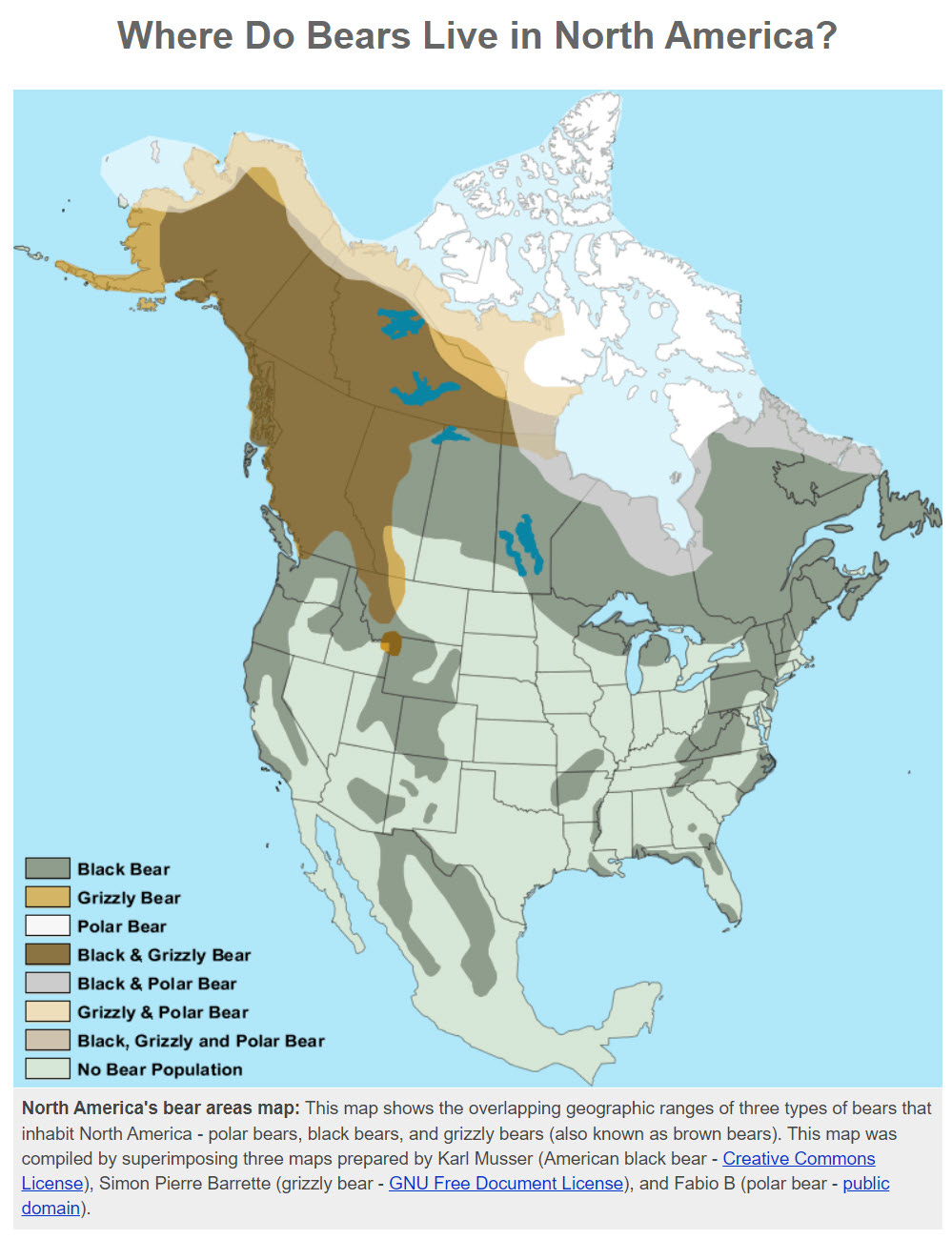Fat Bear Week- Foraging 20 Hours a Day
Plus, a bear encounter highlights a black bear’s superpower
You’re at Mother E, a free newsletter published every other Sunday. I’m telling the stories about our kinship and connections with other species in a climate-changing world. You can read more posts here.
Did you miss the last one? Feeling the weight of a heavy summer
FAT BEAR WEEK HAPPENS EVERY FALL. In 2021, it’s September 29-October 5. This contest at Katmai National Park in southern Alaska highlights the voracious eating habits of its large brown bears (Ursus arctos) along the Brooks River. It’s fun to watch the bears fish for salmon on live game cams. Here are the week’s best highlights from those game cams.
This contest with a humorous name is serious business for bears everywhere. They use the late summer and early fall to put on as much weight as possible to get through the months-long hibernation period. You can see some astonishing before and after photos of weight gain as bears add 30% or more bulk over several months.
To find food, bears use their very keen nose. The American black bear (Ursus americanus) has a sense of smell that’s about 7 times better than a bloodhound dog’s nose. That equals to about 2000 times better than a person’s sense of smell! There are stories of bears traveling from a coastal mountain range to the beach to feast on a whale carcass they smelled. They need lots of food to keep their big bodies going, so nature provides them with one of the world’s best-working noses to find that food.
“A black bear’s sense of smell is so good it’s difficult to measure. Bears are commonly thought to have the keenest sense of smell in the animal kingdom…Conservative estimates of a black bear’s sense of smell state that [they] can smell a food source from over a mile away…More generous estimates place a black bear’s sense of smell between 18 and 20 miles.”
Bear Series, Part One: A Bear’s Sense of Smell National Park Service
A surprise visitor to the camp
I had a firsthand experience of a bear’s powerful ability to smell while on a camping trip some years ago. My husband and I arrived at Convict Lake in the Eastern Sierra Nevada mountains and set up camp one August afternoon. We read all the signs about storing food in the metal bear lockers provided at each camp and dutifully locked up the food and toothpaste after dinner.
We enjoyed a campfire under the stars and then climbed into our tent for the night, with sleeping bags next to the tent walls. I had my overnight duffle bag next to my feet. All was quiet and we drifted off to sleep.
Sometime past midnight, I was awakened by something poking through the tent wall and pushing persistently at my feet. I was annoyed at being awakened out of a dream. I figured it was a raccoon trying to get into the tent, so I put both legs together and kicked one strong sidekick at the sidewall of the tent. I connected with something very solid, which then retreated. What was THAT?
Suddenly I was wide awake. I called to my husband, “Something’s trying to get into our tent!” He groggily awoke and reached for the flashlight but we decided it would be better to stay inside the tent than to venture out into the darkness.
About a minute or two later, a man’s voice at the campsite next to us shouted in alarm, “Bear, bear!!” The man started banging a pan to scare it away. I felt a chill flood over me. Did I just kick a bear in the nose?
There was more disturbance at the camp next door as the man chased the bear away and cleared up the food he must have left out. A smell of smoldering Cheerios filled the air for the next hour. I couldn’t return to sleep for several more hours.
In the morning I pulled out my duffle bag to get my clothes on and see what might have attracted an animal to it. At the bottom of the bag was a forgotten bottle of powdered clover capsules I had been taking. The clover was inside a capsule, inside a plastic bottle with a cap, inside a zipped duffle bag, under a jacket, and inside our tent. The animal, most likely a bear, had smelled it through all those layers! I found out later that bears love nutritious clover and eat it when they come out of hibernation. (The photo at the top of this article shows a bear with some clover in its mouth.)
Do bears live near you?
The bear at our campground was a black bear (Ursus americanus), the most common North American bear. Black bears can be black, brown, or cinnamon-colored. They are the smallest of the American bears, ranging in size from 125 to 500 pounds. They have a wide range, from Southern Mexico up to the top of the Arctic. California has a larger population of black bears, around 30,000, than any other of the lower 48 U.S. states.
Black bears are very adaptable eaters, with 85% of their diet being plant-based and the remaining 15% consisting of insects, fish, bird eggs and nestlings, small mammals, or carrion from larger kills. Occasionally black bears will hunt larger animals. In the early fall before the 3-7 months of hibernation, bears may be looking for food 20 hours a day. The American black bears’ adaptable eating behavior allowed them to survive through the last Ice Age when other predators became extinct.
Bears and humans have a complicated relationship. We are fascinated with them and give children soft toy bears to hug at night, but we also fear these apex predators and kill them regularly.
Bears living near human populations have a much higher mortality rate, but they are drawn there in search of food and water sources. Their preferred habitat is remote forested areas with an understory of plants that provide food such as berries, acorns, and nuts.
Discovering new human and bear connections
We humans eat many of the same foods bears eat: salmon, animal flesh, berries, fruit, grains, and nuts. This similar food consumption leads us to inhabit regions where bears have also lived for thousands of years. Scientists are now finding some deeper connections between bears and humans, as both species shape the environment in which they live.
A study of grizzlies (Ursus arctos horribilis—a subspecies of brown bears) revealed a strong link with native people. Researchers collected DNA samples from bear fur in British Columbia, Canada, and found an overlapping map between three genetically distinct bear populations and three indigenous language groups. Read about that here. They revealed a “mind-blowing” cultural and biodiversity connection between bears and indigenous tribes.
“We and the bears have a lot of the same needs, and it makes sense that we stay fairly close to one area… It’s definitely in line with the fact that most First Nations consider bears to be family. That is something we are very closely tied to.”
Jennifer Walkus, Wuikinuxv First Nations scientist
Understanding the needs of bears, and respecting their strength, intelligence, and territory is a good first step to living more harmoniously with this unique top predator. “The more you learn about bears and how they behave, the less likely you will be to have a negative encounter or misinterpret interactions.” Bears Smart.com
That powerful bear nose—mostly it just wants to find food.
Just the bear facts:
Dexterity— Bears have been known to open latches and screw-top jars.
Delayed egg development—Bears breed from May to July, but the fertilized egg doesn’t implant until fall. Cubs are born during the winter hibernation period.
Hibernation keeps the bear alive during a season of low food. The bear’s heart rate drops from 40 to 50 beats a minute down to 8. Their metabolic rate can drop by 75%, and they do not drink or excrete during this period. They can lose 25-40% of their body weight. The bear still keeps a sense of the length of the days and may wake up and forage for food if the winter is mild.
Bears have a keen sense of smell with millions of scent receptors in their long noses.
Bears have equal or better hearing and eyesight than people
Mother bears are protective parents and good teachers. Cubs stay with them for 16-17 months. There is a lot to learn about being a bear!
I appreciate comments from readers! Have you had close bear encounters?
You can reach me by responding to this email, leaving a comment above, or on Twitter @RobinApplegarth




